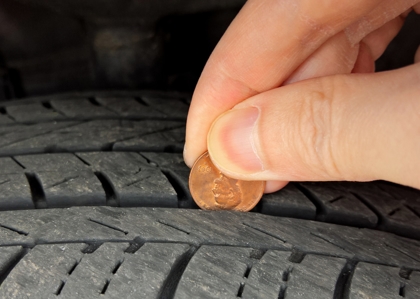Author: Zachary D. Campbell
Most drivers forget that they play an important role in protecting their own safety and automotive investment. Often times, drivers only check their tires during annual inspections or after something unfortunate occurs. Checking your tires on a regular basis is an important safety precaution. Ideally, tire inspections should be performed monthly. Continue reading to learn how to perform the penny test which can help you save up to $0.11 per gallon.
According to the U.S. Tire Manufacturers Association (USTMA), National Tire Safety Week, which was originally scheduled for May 18-24, 2020, is used to “to educate motorists about tire care, safety and maintenance, including the potential dangers of unsafe used tires.” Due to the impact of the COVID-19 pandemic, USTMA postponed its 2020 National Tire Safety Week. A new date will be announced as soon as it is confirmed.
“As we cope as a nation with the COVID-19 health emergency and economic crisis, USTMA felt it was in the best interest of our members and industry partners to reschedule so they can continue to focus on the safety and well-being of their employees, business operations and the communities in which they operate,” says Anne Forristall Luke, president and CEO of USTMA.
“In the interim, USTMA will focus its efforts on educating the public, especially those who may not be driving frequently, on how to ensure proper maintenance and care for their tires, so that when they do need their vehicles, they can do so confidently and safely.”
As a car owner, you play a critical role in preventable accidents, like hydroplaning. Experts recommend regular vehicle maintenance and tire inspections to avoid hydroplaning.
The risk of hydroplaning increases during heavy rains that tend to occur in the spring and summer months. When rain mixes with oil residue on the road surface, it creates slippery conditions that can cause vehicles, especially those traveling speeds in excess of 35 mph, to hydroplane.
What is hydroplaning?
Hydroplaning often occurs when your tires do not have enough traction on a wet road causing your vehicle to lose control. When you hydroplane, your vehicle’s tires do not adequately push the water off the surface of the roadway. The vehicle then rises to the top of the water between your tires and the road. Because of this, you have no traction on the roadway and limited control of the vehicle. This can be exacerbated if your tires are not properly maintained.
What to do if you hydroplane
Panic and slam on the brakes? WRONG! Sudden actions such as braking or turning abruptly can only make matters worse. The best course of action is to slowly take your foot off of the gas pedal while firmly gripping the steering wheel. Once you have a grip on the steering wheel, turn the steering wheel in the same direction that your car is sliding or skidding. By doing so, your tires can realign with your direction of travel. Hydroplaning can often be corrected as quickly as it started. When your tires regain traction with the roadway, maintain your speed and the direction of travel. To prevent hydroplaning reduce your speed while traveling on wet roads until the weather and road conditions improve.
What is the penny test?
Check your tires regularly for wear and tear, this can also prevent hydroplaning. Driving on tires with worn-down tread is dangerous. The National Highway Traffic Safety Administration (NHTSA) recommends that your tire’s tread depth is more than 1/16th of an inch to be safe. Any measurement at or below 1/16th of an inch is considered unsafe because the tires can no longer effectively navigate wet, slushy, or snowy roads.
There are several popular ways to check your tire tread depth. One easy way is with the penny test. Simply insert a penny into your tire's tread groove with Lincoln's head upside down and facing you. If you can see all of Lincoln's head, your tread depth is less than 1/16th of an inch and it's time to replace your tires.

How can you save $0.11 per gallon of gas?
Maintaining your car is a simple and effective way to increase mpg and help prevent hydroplaning. According to the NHTSA, properly inflated and aligned tires = 3% better gas mileage = $0.11 savings per gallon.
It is recommended to check your tire air pressure once per month and your tire’s rubber breakdown annually. Direct sunlight can heat the rubber and cause premature deterioration. The UV rays penetrate the rubber, dry it out, and eventually breakdown the rubber compounds. The best way to keep tires from dry rotting is to limit sun exposure whenever possible. NHTSA recommends rotating your tires every 5,000 to 8,000 miles or sooner if uneven wear appears.
We can never eliminate the hazards of rainy weather driving or the risk of hydroplaning, but the dangers can be minimized by observing recommended safety precautions.
If you are injured in a truck, automobile, or motorcycle accident, the Metzger Wickersham legal team is available to discuss your case. We can answer your questions and provide legal advice during a no-cost case evaluation. To schedule a free consultation with our attorneys, complete our contact form or call (888) 286-2850.
